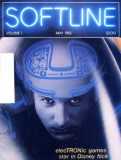
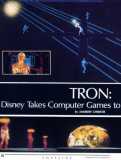
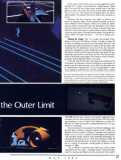
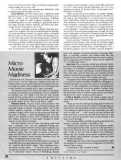
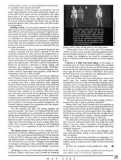
Once upon a time, there was a young programmer who worked for a huge communications conglomerate. These days, he owns his own video game arcade and is the best gamer in town. He is also the author of the wildly successful Space Paranoids, and success has brought with it an inevitable problem: he suspects his former boss at the company of piracy. Breaking into the company one night to retrieve evidence of program thefts, the boy genius stumbles across his boss's Master Control Program, which has a knack for patching into others' computers — like the Pentagon's. He is even more surprised when the MCP activates a security laser behind him, which proceeds to disassemble his basic molecular structure and scatter it through several miles of computer circuitry. When he opens his eyes ... he isn't in Kansas anymore. Making the Magic. The Tron trailers are parked three-deep on the lot at Walt Disney Studios. In trailer number 10, an artist is wielding an airbrush over the vector lines of a video game grid scene, adjusting the valves of the air tanks, and swearing into the telephone. Across from him, four ink-and-paint girls, plugged into their Walkmans, are offloading several dozen crates full of the latest character eels, each cel representing one-fourth of one frame of film. The cels are now ready to be photo-rotoscoped, one frame at a time, for backgrounds, special lighting effects, and color. At the far end of the trailer, Jerry Rees is hunched over his Chromatics Synthavision terminal waiting for transmission of motion tests for the next scene. Larry Elin is on the other end at Mathematics Applications Group Incorporated in New York waiting to send the tests over the modem from a Celco CFR 4000. On this day, however, the eastern seaboard is pre-occupied with its worst spring blizzard since 1915 and nothing is going in or out of New York. Patience is a virtue. Patience is all. After ten months in postproduction for Tron, patience is a necessity. No one has been more patient than Steven Lisberger, who got the idea of doing a computer game movie in 1978. As a student at the University of Boston, Lisberger had made the short Cosmic Cartoon, a series of camera pans over fantastically beautiful Greek classical and interstellar landscapes, accompanied by Hoist's Planets. With this animation credit, he and partner Donald Kushner brought their idea for a movie set in a world of computer arcade games to Disney in the summer of 1980. "It's to Disney's credit that they didn't say, 'Call us when computers can do a dog,' " Lisberger recalls. "We were interested in creating real objects and environments that couldn't exist in the physical world. That's something computer-generated images can do very well." Tron is the movie that demonstrates definitively what computer-generated imagery can do. […]
| Id | 2985 |
|---|---|
| Availability | Free |
| Inserted | 2016-12-23 |